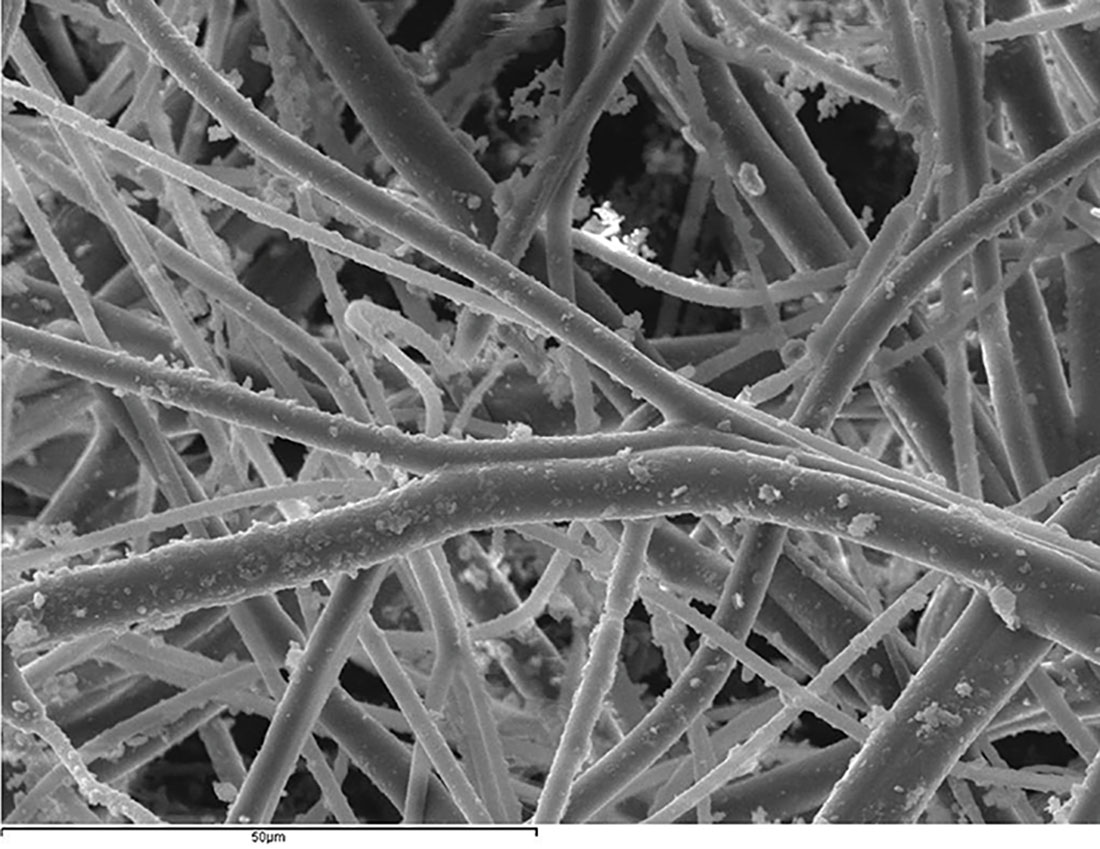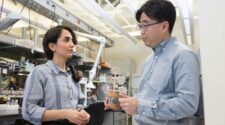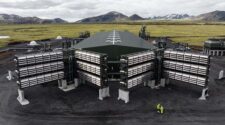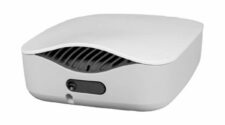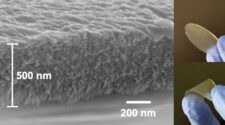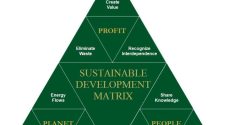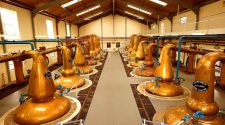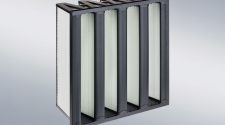Dr. Iyad Al-Attar Explains Why Filtration Technologies Alone Cannot Sustainably Capture Our Anthropogenic Emissions
Climate change is an insidious problem whose definition is elusive and for which definitive solutions may
be lacking, as Frank Incropera[1] indicates in his book, Climate Change: A Wicked Problem. Positioning humanity to resolve climate change challenges requires an intrinsic understanding of our environmental
status quo. We are running amuck with current anthropogenic emissions, and possessing advanced filtration technologies does not justify the current pollution actions. Eventually, embracing sustainability becomes the only way forward as “business as usual” models can risk our existence, particularly if we continue with current polluting conduct and linear economic endeavors.
The Atmospheric Aerosol
The air we breathe consists of particles emitted from natural events such as sandstorms, volcanoes, forests, sea spray, and anthropogenic sources, which refer to those emitted by human activities.[2,3] Atmospheric air is full of microscopic particles, which can be health hazardous and thus considered a
specific type of air pollution. The dynamic mixture of atmospheric solid and liquid particles emitted from various sources poses a significant challenge for filter performance prediction. Therefore, it is difficult to generalize the atmospheric air’s physical and chemical characterization, challenging installed air filters that rely on outdoor air. Consequently, it is typical for actual filter performance to deviate from laboratory test reports, which can be due to location sensitivity and filter loading with various atmospheric pollutants. The interaction between particle characteristics such as concentration, size, distribution, shape, and filter media properties also impacts filter loading and performance. Investigating such interaction helps predict the filter’s lifetime and performance in terms of the rise in pressure drop and the efficiency filters provide before replacement.
Addressing global air quality complexities requires scientists, policymakers, and industry leaders to work together to enable communities to embrace responsible and sustainable living in healthy building envelopes. Catchy “sustainability” slogans and “green and clean” planet wishful thinking will not amount to much if we lose track of resolving air quality challenges.
Fibrous Filters
![Figure 2: Typical filtration challenges in air handling unit [left], gas turbine [center], sewage plant [right].](https://www.filtnews.com/wp-content/uploads/IFN_2_2024_indoorair_attar_fig2.jpg)
To avoid living in a building envelope of peril, fibrous filters (Figure 1) are called upon to capture unwanted particles before introducing outdoor air indoors. Fibrous filtration is commonly used in many filter applications such as HVAC, automobiles, sewage plants, and the intake of land-based gas turbines (Figure 2). Fibrous air filters used in HVAC applications rely on depth particle deposition on filter fibers where the feed concentration is low, and filter porosity is high (Figure 3).
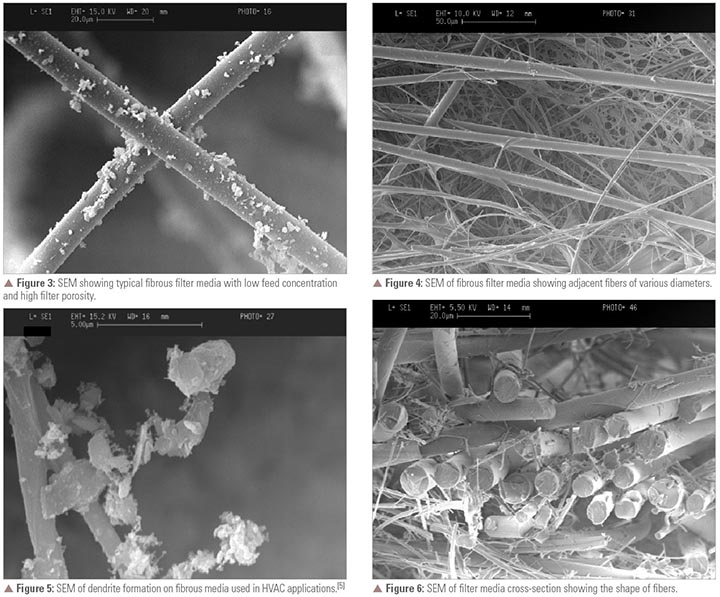
Fiber size distribution and adjacent fibers (Figure 4), dendrite formation (Figure 5), fiber shape (Figure 6), and charge influence the loading of filters.[4] Ultimately, filter efficiency and dominant capture mechanisms depend upon many interrelated factors such as aerosol size, density, face velocity, media porosity, filter media, and particles’ physical and chemical characteristics. Failing to understand the interplay among all these parameters can lead to surface deposition on a depth filter media (Figure 7), thus reducing its lifetime and leading to pre-mature clogging.
![Figure 7: SEM of pre-mature dust-cake formation on a depth filter media.[5}]](https://www.filtnews.com/wp-content/uploads/IFN_2_2024_indoorair_attar_Fig7.jpg)
Ultimately, pre-filtration can be pivotal in lowering particle concentration and adjusting particle size distribution to facilitate further depth deposition. Appropriate pre-filter selection can extend the stationary filtration stage, where particle deposition causes a negligible rise in the installed filter’s pressure. Engineered multistage filtration utilizing pre-filters helps maintain the filter’s permeability (Figure 8), and extends its lifetime while ensuring a sustainable performance.
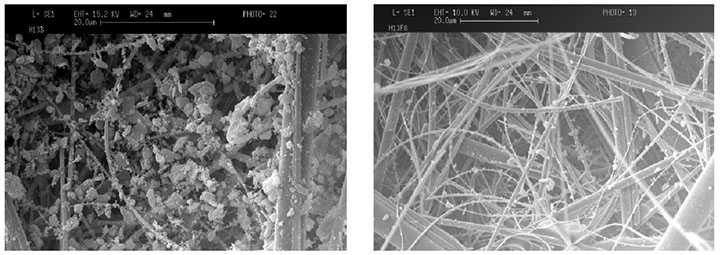
The Impact on HVAC Equipment and Air Filter Performances
Globally, the built environment uses one-fifth of all the electricity used in buildings for space cooling.[6] That represents 26% of global energy-related emissions, highlighting tremendous energy saving opportunities to lower their environmental footprint.[7] Therefore, appropriate employment of aerodynamic filters and performance prediction accompanied by sustainable operation and maintenance of HVAC systems are paramount to meeting energy efficiency targets.
Anthropogenic emissions alter ambient conditions surrounding HVAC and filtration systems and impact their predicted performances differently. Outdoor air pollution can further challenge the installed HVAC and filtration systems and spark additional complexities in managing and measuring IAQ and conducting professional maintenance practices while adhering to energy efficiency goals. Exposure to various pollutant types and high concentrations can severely load air filters. Inappropriate filter installation and leakage lead to pollutant deposits on the cooling/heating coils, compromising the heat transfer mechanism on the one hand but also changing the dynamics of filter loading on the other hand. Furthermore, high moisture levels and particle concentrations can reduce the filter’s permeability,
impeding HVAC equipment to deliver the required thermal comfort and ventilation flow rates.
Chronic Filter Failure
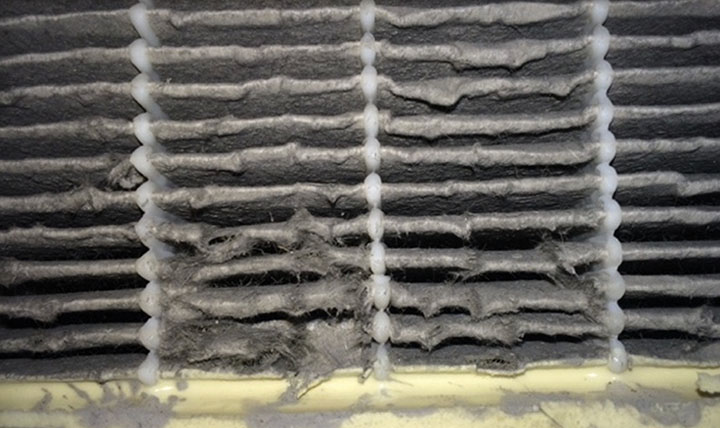
The overall objective of filtration for HVAC systems is to render the filtered air fit-for-purpose given the application. However, it is challenging to improve air quality if chronic filter failure is the norm in a typical HVAC system operation and maintenance. Figure 9 shows pleat deformation and rupture of a depth filter installed in a typical air handling unit, leading to leakage and efficiency degradation. Inappropriate maintenance and attempting to regenerate a disposal fibrous filter by compressed air damages the filter media and will never allow the filter to be reset to its original efficiency. Furthermore, squeezing mechanical air filters in limited spaces within air-handling units lowers the efficiency ceiling that can potentially be achieved. Ultimately, such limitations impede any attempt to provide sustainable
filter performance to enhance air quality, failing to give spaces for higher filtration efficiency through multistage filtration against targeted pollutants. Appropriate filter selections should look beyond particle capture and the sole reliance on mechanical filters, which requires an engineering approach to provide sustainable air filter performance.
It is Not Only Particle Capture
Dust removal immediately comes to mind whenever air filtration is addressed, as if dust is the only harmful contaminant to our respiratory systems. Minimal emphasis, at best, is placed on contaminants in the atmosphere, such as radon, soot, carbonaceous particles, greenhouse gases and bioaerosols. We must step back to gain a broader perspective of the contaminants surrounding us, requiring thorough characterization analysis to make appropriate filter selections.
Today, the premise of proper filter selections should look beyond particle capture to entail similar filtration solutions for gases and bioaerosols. However, engineering and employing fit-for-purpose filtration systems should be only one of many foci. We must ask ourselves why we are polluting horrendously and spending tremendously on filtration and other mitigation technologies to re-capture what we just emitted.
Looking Beyond the Filter’s Pressure Drop
The performance characteristics of air filters are efficiency, performance, and lifetime during operation. To ensure such operation is sustainable, we need to go the extra mile and employ online measurement of air filter performance, which can prove invaluable in monitoring its efficiency, not just the rise in pressure drop. Ultimately, that would grant data-driven decisions based on feedback loops for an optimal operational lifetime. Particle deposition on diffusers, cooling/heating coils, and eventually onto our lungs indicate that poor or no filtration was entertained. Failing to comprehend the risk of inhaling polluted air raises a red flag about our readiness to avail filtration technologies to confront particle and virus transmission through HVAC equipment. No wonder pandemics do not come along with wake-up calls; they swiftly storm cities, economies, building envelopes, and our respiratory systems, leaving the surviving to bury loved ones and abandon their built environment.
Although air filtration is not the leading cause of poor indoor air quality (IAQ), filters are frequently sought to tackle IAQ ills. The demand for more stringent filtration standards, tweaked measures, and approaches to filter testing, installation, and performance is rising. However, crafting standards alone without air quality policies and incentive programs for concrete implementation leaves much to be desired. Sound planning, relevant standards, and assiduous guidance to adroit compliance and implementation should be the order of the day to deliver clean air to humanity equally, successfully, and sustainably.
Driving Change
Clustering people in polluted cities cannot be celebrated, and the solution to the rising tide of air pollution cannot lie simply in a filtration delirium to chase every airborne particle. Embracing sustainability is everyone’s business, and bringing about change requires everyone in every sector to make their fair share of contributions. Air quality inclusion is a core undertaking in sustainable urban development so we can collectively live, grow, and urbanize without polluting. Addressing global air quality complexities requires scientists, policymakers, and industry leaders to work together to enable communities to embrace responsible and sustainable living in healthy building envelopes.
Moving Towards Sustainability
Catchy “sustainability” slogans and “green and clean” planet wishful thinking will not amount to much if we lose track of resolving air quality challenges. Today, the increasing population in cities and anthropogenic emissions deteriorate air quality and provide the ideal conditions for diseases to spread, vary, and thrive. It is naive to think that pandemics like SARS-CoV-2 will be once-in-a-generation events, and vaccinations and employment of high-efficiency filters alone would poise infectious diseases for defeat. Humanity must embrace efficient processes and modern infrastructure and depend on responsible policymakers and individuals to tackle the dismayingly long list of challenges over the following decades. Environmental degradation, global warming, and proliferating pandemics hinder our ability to respond to these challenges, which will require scientific and engineering breakthroughs and will be critical for future generations. A paradigm shift is imperative to attain and maintain healthy environments filled with clean air as we transition to pandemic-proof cities.
Ultimately, ascending the air quality heights entails engaging HVAC and their associated filtration systems to respond to any variation in IAQ. Buildings’ system adaptivity based on humancentric concepts and observance of energy efficiency do not have to be mutually exclusive. Enshrining air quality governance within legislation hold immense promise to drive change toward building envelope designs that enhance the well-being of human occupants far and beyond conventional settings.
References:
- Incropera, F.P., 2016. Climate change: a wicked problem: complexity and uncertainty at the intersection of science, economics, politics, and human behavior. Cambridge University Press.
- EPA, 2005. Review of the national ambient air quality standards for particulate matter: policy assessment of scientific and technical information. OAQPS Staff Paper.
- Hinds, W.C. and Zhu, Y., 2022. Aerosol technology: properties, behavior, and measurement of airborne particles. John Wiley & Sons.
- Wakeman, R., 2007. The influence of particle properties on filtration. Separation and Purification Technology, 58(2), pp.234-241.
- Al-Attar, I.S., 2011. The effect of pleating density and dust type on performance of absolute fibrous filters (Doctoral dissertation, Loughborough University).
- IEA (2018), The Future of Cooling, IEA, Paris https://www.iea.org/reports/the-future-of-cooling, License: CC BY 4.0.
- IEA (2023), World Energy Outlook 2023, IEA, Paris https://www.iea.org/reports/world-energy-outlook-2023, License: CC BY 4.0 (report); CC BY NC SA 4.0 (Annex A).


